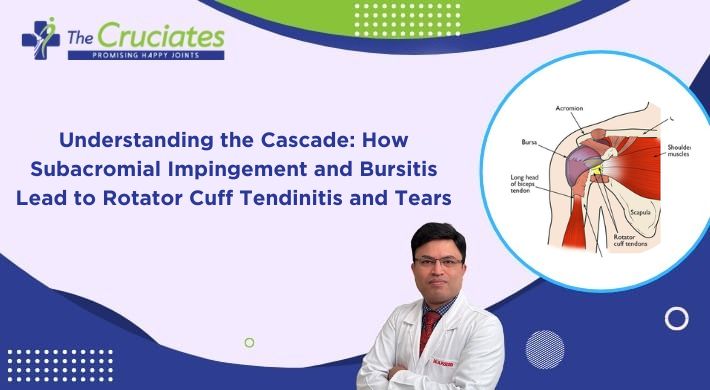Subacromial impingement syndrome is a common shoulder ailment that affects many individuals, particularly athletes and those engaged in repetitive overhead activities. This condition, often accompanied by subacromial bursitis, can set off a chain reaction of damage within the shoulder joint, ultimately culminating in rotator cuff tendinitis and tears. In this comprehensive guide, we delve into the intricacies of this cascade of events, exploring the connections between subacromial impingement, bursitis, and the development of rotator cuff pathology.
Understanding Subacromial Impingement:
Subacromial impingement occurs when structures within the shoulder joint, such as the rotator cuff tendons and subacromial bursa, become compressed or irritated during shoulder movements. This compression often occurs beneath the acromion, the bony prominence of the scapula. Factors contributing to impingement include anatomical variations, such as shape and size of the acromion, as well as muscular imbalances and poor shoulder mechanics.

The Role of Subacromial Bursitis:
Subacromial bursitis frequently accompanies impingement syndrome and exacerbates the inflammatory process within the shoulder joint. The subacromial bursa, a fluid-filled sac located between the acromion and rotator cuff tendons, serves to reduce friction during shoulder movements. However, when subjected to repetitive stress or trauma, the bursa can become inflamed, resulting in pain, swelling, and further impingement of surrounding structures.
The Path to Rotator Cuff Tendinitis:
As subacromial impingement and bursitis persist, the rotator cuff tendons endure ongoing friction and compression. This repetitive stress leads to degeneration and microtrauma within the tendons, a condition known as rotator cuff tendinitis. Patients with rotator cuff tendinitis often experience localized shoulder pain, particularly with overhead activities or reaching behind the back. Without intervention, this inflammatory process can progress, predisposing the rotator cuff to more severe injuries.
The Development of Rotator Cuff Tear:

Continued strain on the rotator cuff tendons, exacerbated by impingement and bursitis, increases the risk of structural damage, including partial or full-thickness tears. Rotator cuff tear can occur gradually over time due to chronic degeneration or suddenly as a result of acute trauma. Individuals with untreated impingement and bursitis are particularly susceptible to rotator cuff tear, which can significantly impair shoulder function and lead to debilitating pain and weakness.
Diagnosis and Treatment:
Diagnosing subacromial impingement, bursitis, and associated rotator cuff pathology typically involves a comprehensive evaluation, including a thorough medical history, physical examination, and imaging studies such as X-rays, ultrasound, or magnetic resonance imaging (MRI). Treatment strategies aim to alleviate pain, reduce inflammation, and address underlying biomechanical issues. Conservative management may include rest, activity modification, physical therapy, anti-inflammatory medications, and corticosteroid injections. In cases where conservative measures fail to provide relief, surgical intervention, such as arthroscopic decompression or rotator cuff repair, may be necessary to address structural abnormalities and restore shoulder function.
Prevention and Rehabilitation:
Preventing subacromial impingement and bursitis involves maintaining optimal shoulder mechanics, strengthening the rotator cuff and scapular stabilizers, and avoiding activities that exacerbate symptoms. For individuals already experiencing shoulder pain or dysfunction, early intervention with targeted rehabilitation exercises can help improve range of motion, strength, and stability, thereby reducing the risk of progression to more severe rotator cuff injuries. Rehabilitation protocols may include stretching, strengthening, and neuromuscular retraining tailored to the individual’s specific needs and functional goals.
Conclusion:
Subacromial impingement and bursitis represent common shoulder conditions that can lead to significant morbidity if left untreated. By understanding the interconnected nature of these conditions and their potential to precipitate rotator cuff tendinitis and tears, healthcare providers can implement timely interventions to mitigate pain, restore function, and prevent long-term disability. Through a multidisciplinary approach encompassing conservative management, surgical intervention, and comprehensive rehabilitation, individuals suffering from shoulder impingement syndrome can achieve optimal outcomes and resume their active lifestyles with confidence.
In this article, we have explored the cascade of events linking subacromial impingement and bursitis to the development of rotator cuff pathology, highlighting the importance of early recognition and intervention in managing these conditions effectively. By emphasizing prevention, rehabilitation, and patient education, healthcare professionals can empower individuals to take control of their shoulder health and minimize the impact of these debilitating injuries.
Latest Blogs:

